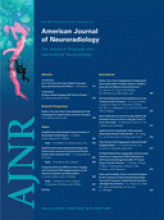Abstract
BACKGROUND AND PURPOSE: Observing changes to water diffusivity and fractional anisotropy (FA) for particular hippocampal regions may improve the sensitivity and specificity of diffusion tensor MR imaging for hippocampal pathologies like Alzheimer disease and mesial temporal sclerosis. As a first step toward this goal, this study characterized the cytoarchitectural features underlying diffusion anisotropy in human hippocampus autopsy specimens at 60-μm in-plane resolution.
MATERIALS AND METHODS: Eight-millimeter coronal segments of the hippocampal body were dissected from 5 autopsy specimens (mean = 55.6 ± 6.2 years of age) with short postmortem intervals to fixation (21.2 ± 5.7 hours) and no histologic evidence of neuropathology. Diffusion tensor microscopy data were collected from hippocampal specimens by using a 14.1T magnet with a protocol that included 21 unique diffusion gradient orientations (diffusion time = 17 ms, b = 1250 s/mm2). The resulting images were used to determine the mean diffusivity, FA, and principal fiber orientation for manually segmented hippocampal regions that included the stratum oriens, stratum radiatum, stratum pyramidale (CA1 and CA3), stratum lacunosum-moleculare, hilus, molecular layer, granule cell layer, fimbria, and subiculum.
RESULTS: Diffusion-weighted images had high signal-to-noise ratios (31.1 ± 13.0) and delineated hippocampal anatomy well. Water diffusivity ranged from 1.21 ± 0.22 × 10−4 mm2/s in the fimbria to 3.48 ± 0.72 × 10−4 mm2/s in granule cells (analysis of variance, P < .001). Color fiber-orientation maps indicated the underlying microstructures responsible for diffusion anisotropy in the hippocampal lamina.
CONCLUSION: Diffusion tensor microscopy provided novel microstructural information about the different lamina of the human hippocampus. These ex vivo data obtained at high-magnetic-field strengths can be used to study injury-specific diffusion changes to susceptible hippocampal regions and may lead to more specific MR imaging surrogate markers for Alzheimer disease or epilepsy.
- Copyright © American Society of Neuroradiology












